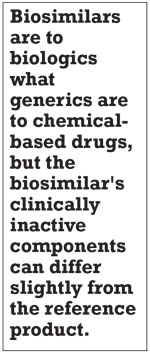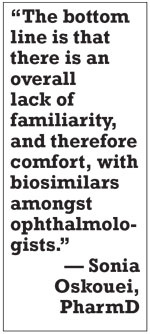Take-home Points
|
 |
As patents for ranibizumab and aflibercept approach expiration and one anti-VEGF biosimilar application awaits approval in the United States, interest in biosimilar versions of these biologic agents is peaking. Recent clinical trials of ranibizumab biosimilars have reported equivalence with the reference agent. Major pharma companies, including Novartis and Bausch + Lomb, have taken recent steps to advance their own biosimilar development programs. And President Joseph Biden recently signed legislation aimed at fixing the oft-maligned regulatory pathway for biosimilars.
 |
Biosimilars are replicated versions of biologic agents that may be commercialized once the reference agent comes off patent. Biosimilars are to biologics what generics are to chemical-based drugs, but where the active ingredients of generics are the same as their reference brand-name drugs, the clinically inactive components of biosimilars can differ slightly from the reference product.
Ranibizumab (Lucentis, Genentech/Roche) comes off patent in the United States this year, and loses its European patent protection in 2022, while aflibercept (Eylea, Regeneron Pharmaceuticals) comes off patent in 2023 in the United States and 2025 in Europe.
Clinical trial results
No fewer than eight anti-VEGF biosimilars are under development, four referencing each aflibercept and ranibizumab. South Korea-based Samsung Bioepis and U.S. partner Biogen last year filed for Food and Drug Administration approval for its ranibizumab biosimilar candidate, SB11. This biosimilar candidate was also the subject of one of two trial results published this year.1 In 705 patients, the trial found SB11 equivalent to the reference drug in terms of best-corrected visual acuity at eight weeks and optical coherence tomography central subfield thickness at four weeks.
The second trial, a 48-week study of FYB201 (Bioeq) in 477 patients with neovascular age-related macular degeneration, found equivalence with reference ranibizumab for BCVA improvement and ocular and systemic safety.2
Economics of biosimilars
Eight biosimilars in the retina pipeline Here’s a quick look at potential biosimilars under development. Ranibizumab biosimilars are:
Aflibercept biosimilars include:
And there is one bevacizumab biosimilar in the pipeline:
|
The appeal of biosimilars is cost. The health information technology/clinical research company IQVIA estimates that overall savings from biosimilars could exceed $100 billion by 2024. “With an average discount range of 15 to 30 percent for the biosimilars thus far, these agents are expected to bring cost savings to some of the most common treatment options for neovascular age-related macular degeneration,” says Sonia T. Oskouei, PharmD, vice president of biosimilars for the global health-care services company Cardinal Health. The cost of Lucentis and Eylea is between $1,800 and $2,000 a dose.
But in the United States, with off-label bevacizumab (Avastin, Roche/Genentech) already holding a commanding market share in retina, ophthalmology may be an anomaly among medical specialties in which biologics use is widespread. Medicare and commercial payers typically reimburse between $50 and $125 for an injection of Avastin.
For pharmaceutical companies,
anti-VEGF drugs have been a big payday. Regeneron reported $4.95 billion in Eylea sales in 2020. Bayer, distributor of Eylea outside the United States, recorded $3 billion in sales of that agent in 2020. Roche, parent company of Genentech, reported U.S. sales of $1.3 billion for Lucentis last year, a decline of 16 percent from the previous year. Novartis, which holds Lucentis rights outside the United States, reported $1.93 billion in Lucentis sales in 2020.
Overcoming regulatory barriers
 |
In the United States, the regulatory pathway for biosimilars has historically been dodgy. Congress passed the Biologics Price Competition and Innovation Act (BPCIA) in 2010 that, in effect, was supposed to create an abbreviated regulatory approval process for biologic products that are “highly similar” to and have no clinically meaningful differences from a previously approved product. But the Food and Drug Administration was slow in writing regulations. Biosimilars developers became frustrated with how the agency defined “interchangeability,” which allows a pharmacist to substitute a biosimilar for the reference product. Over the years, a series of FDA commissioners pledged to fix the process, to little avail.
This spring, President Biden signed two pieces of legislation that could make biosimilars more widely available. In April he signed the Advancing Education on Biosimilars Act. Meaghan Rose Smith, executive director of the trade group Biosimilars Forum, says the law is “to
ensure that patients and providers have all of the educational resources and materials they need to be assured of the safety and efficacy of biosimilars.” The Biosimilars Forum notes the bill requires the FDA to advance education and awareness among healthcare providers about biological products. That includes developing or improving continuing education programs.
The bill also empowers the FDA to host a website that provides educational materials to providers, patients and caregivers, regarding the meaning of the terms, and the standards for review and licensing of, biological products, including biosimilars.
In May Biden signed the Ensuring Education Act, which would tighten regulations on what biologics and chemical-based drugs qualify for product exclusivity protection. The Center for Biosimilars says the law would close loopholes that let pharmaceutical companies get patent protections for drugs that don’t represent true innovations.
“The Advancing Education on Biosimilars Act is intended to lower healthcare costs by strengthening provider and patient confidence in biosimilars through enhanced educational efforts, thereby increasing utilization,” says Cardinal Health’s Dr. Oskouei.
It should, she adds, help providers better understand terms embedded in the BPCIA, such as interchangeability and extrapolation (the regulatory principle of extrapolating efficacy and safety data from one indication to another if trials show biosimilarity to the reference product).
Retina specialists need some of that education
In an opinion piece for The Center for Biosimilars, Dr. Oskouei reported on results of a survey of 37 community-based retina specialists.3 The survey found that 31 percent said they’re not very familiar with biosimilars, and 55 percent said they’ve read research about them but aren’t familiar with specifics. However, 83 percent said they thought biosimilars would fit into their treatment regimens and would help keep drug costs down, and more than half said they would consider using a biosimilar of ranibizumab or aflibercept.
“The bottom line is that there is an overall lack of familiarity, and therefore comfort, with biosimilars amongst ophthalmologists,” Dr. Oskouei says. “There is a significant need for biosimilar education amongst ophthalmologists, especially as we anticipate our first ophthalmology biosimilar later this year.”
The Cardinal Health survey has since been updated. Dr. Oskouei says that responses from 75 U.S. retina specialists revealed that 24 percent thought biosimilars’ clinical trials aren’t adequately powered to appropriately evaluate efficacy and safety. And 35 percent said they have “very limited knowledge” of what goes into designing clinical trials for biosimilars.
 |
|
In India, Ashish Sharma, MD, has seen the impact of biosimilars in retina, but explains why that may not translate to the United States. |
“When asked about primary concerns with prescribing biosimilars once available, ‘uncomfortable from a clinical standpoint’ and ‘payer coverage concerns’ were equally rated as the top answers across all respondents,” she says.
Then there’s the Avastin dynamic. “In addition to the clinical comfort aspect with biosimilars, there is a strong desire to understand the financial implications of these products as well, especially given common use of low cost, off-label bevacizumab currently in ophthalmology,” Dr. Oskouei adds.
Unicorn anti-VEGF market
As a retina specialist in Coimbatore, India, Ashish Sharma, MD, has first-hand experience with
anti-VEGF biosimilars. The first commercialized ranibizumab biosimilar was launched there in 2015, and he’s reported on a number of biosimilar trials at U.S. meetings.
He also understands why the U.S. market is different. “In the United States, with Avastin, you have good compounding pharmacies, so that means, in the U.S. physicians’ hands, Avastin is being used quite well, with a lot of safety,” he says.
However, in India and other countries, anti-VEGF biosimilars hold greater promise. “In India and probably in many other developing countries, we do not have that kind of robust compounding pharmacy system,” he says.
With the first biosimilar nearing approval here, U.S. retina specialists will soon find out how that fits with Avastin in their practice. RS
REFERENCES
1. Woo SJ, Veith M, Hamouz J, et al. Efficacy and safety of a proposed ranibizumab biosimilar product vs a reference ranibizumab product for patients with neovascular age-related macular degeneration: A randomized clinical tria JAMA Ophthalmol. 2021;139:68–76.
2. Holz FG, Oleksy P, Ricci F, Kaiser PK, Kiefer J, Schmitz-Valckenberg S. Efficacy and safety of biosimilar FYB201 compared with ranibizumab in neovascular age-related macular degeneration. Ophthalmology. Published online May 2, 2021.
3. Oskouei ST. Opinion: Is the ophthalmology market ready to embrace biosimilars? Center for Biosimilars website. Posted January 16, 2021. Available at: https://www.centerforbiosimilars.com/view/is-the-ophthalmology-market-ready-to-embrace-biosimilars- Accessed April 27, 2021.



